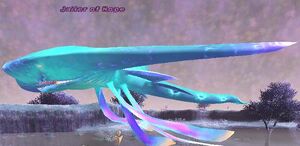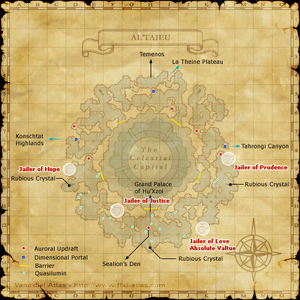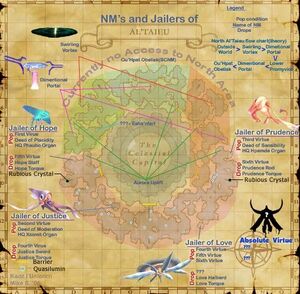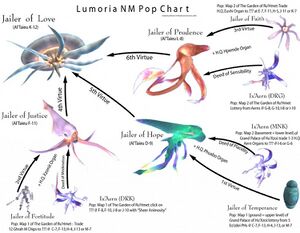Jailer of Hope
| Zone | Level | Drops | Steal | Spawns | Notes |
|---|---|---|---|---|---|
| Al'Taieu | 85 |
|
1 | A, T(H) | |
|
HP = Detects Low HP; M = Detects Magic; Sc = Follows by Scent; T(S) = True-sight; T(H) = True-hearing JA = Detects job abilities; WS = Detects weaponskills; Z(D) = Asleep in Daytime; Z(N) = Asleep at Nighttime; A(R) = Aggressive to Reive participants | |||||
Notes:
- Spawned by trading First Virtue, Deed of Placidity and HQ Phuabo Organ to a ??? at D-9.
- Uses all the Phuabo abilities.
- Seems to favor Aerial Collision over other Phuabo abilities.
- Also uses a stronger version of Tidal Dive, if over deep water.
- May use Mighty Strikes multiple times.
- If Jailer of Hope uses the Phuabo ability Plasma Charge, he shortly gains the ability to instantly cast Burst II and Thundaga III. Plasma Charge can be dispelled, although the ability to cast the spells can not. Taking measures to avoid these spells is highly recommended (Shadowbind works very well).
- Melee attacks have the effect of Stun
- Is 100% resistant to magical Stun, but susceptible to job ability stuns such as Weapon Bash.
Dialogue
The ??? at D-9 says:
A distant voice emanates from the depths of your soul.
"Knoweth...thou?"
"Firs...irtue..."
"Deed...tranqu...ser...ity..."
"...receptac...from phua..."
"...I...cannot...deciph...them..."
The fragmented dialogue is referring to the First Virtue, the Deed of Placidity (tranquility, serenity) and a HQ Phuabo Organ (the receptacle from a Phuabo).
Historical Background
The Heavenly Virtues
The 7 Jailers of Sea are based on the 7 Virtues. Virtue is defined as moral excellence. Virtue can accordingly be characterized as having desirable character traits, traits which direct a person to act in accord with the best possible standard. In other words, Virtues improve us towards the idealized perfection of our being. In order to be virtuous, one must continuously have virtues as habits of their character. The idea of Virtues originate with the ancient Greeks and the idea was later picked up and made a part of Christian moral theology, probably during the Medieval era. There are 2 sets of virtue: the cardinal virtues (sometimes called the classical virtues) & the theological virtues. The former originate with the ancient Greeks and the latter originates in the Bible (New Testament), specifically 1 Corinthians 13, but became popular in Medieval Christianity. The cardinal virtues are: Prudence/Wisdom, Justice, Fortitude/Courage, Temperance. The theological virtues are: Faith, Hope, Charity/Love. Together, these seven virtues were called the Heavenly Virtues or simply the Seven Virtues. The pairing of these seven virtues appeared to have originated with 13th century Christian philosopher Thomas Aquinas in his work "Summa Theologica". They became a popular element for depiction in the Medieval and Renaissance periods.
According to ancient Greek philosophy, they viewed each Virtue as being the mean on a spectrum of some characteristic. As such, each Virtue would have 2 vices associated with it, lying at the extremes of that spectrum. Note that the Virtue was the mean, not necessarily the median between both vices. According to Medieval Christian thought, these virtues are said to improve one's love of God and Man. The cardinal virtues are dispositions of one's being which govern one's actions, restrain their passions and guide their conduct in accordance with reason. The theological virtues are said to give Christians the ability to live in a relationship with the Holy Trinity. They are considered to give life to all the moral virtues (the cardinal and theological virtues). The Heavenly Virtues are generally limited to the Roman Catholic denomination of Christianity. It should be noted the Chinese, Muslim, and other cultures have different sets of virtues.
The seven Heavenly Virtues do not align up with the Seven Deadly Sins. The seven Holy Virtues (or Contrary Virtues) do though, which are: Humility (counters Pride), Kindness (counters Envy), Patience (counters Wrath), Abstinence (counters Gluttony), Chastity (counters Lust), Liberality (counters Greed), Diligence (counters Sloth).
The Virtue of Hope
Hope (Spes) is one of the Virtues. It is a theological virtue. Hope is a wish for something to be fulfilled, confident (to some degree) that the wish will come true. Innate in Hope is optimism and perseverance (because it is a wish and desire for something to come true even if there is evidence to the contrary or the odds of it occurring are unlikely). It should be noted that Hope was the last thing to come out of Pandora's Box in Greek mythology, a box filled primarily with all the character flaws humans can be afflicted with.
According to Medieval and Renaissance-era Christianity, Hope was the Virtue which gave people the desire to achieve the ideal endpoint for the religion, the Kingdom of Heaven and eternal life and happiness therein. Hope allows mankind to aspire and follow the course needed to reach Heaven. It gives one the ability to not be bogged down by discouragement and Hope can sustain one through times they feel abandoned or alone. They believed Hope was accompanied by the gift of timor (fear, specifically God-fearing) and it could challenge the vice of despair.
In Medieval and Renaissance art, Hope is frequently depicted as a calm-expressioned woman holding an anchor, which is traditionally considered the symbol of Hope (the iconography of an anchor representing Hope is seen on many heraldic shields or banners). Notice how the Phuabo resembles an anchor in its form. This is the likely reason why Square-Enix selected that type of monster to be the Jailer of Hope.
The Jailers of Sea
It is not clear what the proper context of the Jailers is. "Jailer of (Virtue)" can be taken two ways. First, it can imply they are the Jailer of (Virtue), imprisoning that Virtue (or more specifically, imprisoning one aspect of Absolute Virtue). This would mean they do not possess the Virtue, they jail it. Second, it can imply they are the Jailer of (Virtue), being a jailer possessing that virtue. This would mean they are a jailer which possesses the Virtue in question. In this case, they would not be jailing the Virtue in their name, they would be jailing the monster known as Absolute Virtue. The latter interpretation is more logical since each Jailer drops a weapon and a torque bearing their namesake Virtue. If they were to be jailing the Virtue in question, it would make more sense for them to drop weapons and torques not named after the virtue, like objects named after the 7 Vices or the 7 Sins. Since the title you gain for defeating Absolute Virtue is "Virtuous Saint," this is the more widely accepted context. However, the former also makes sense because if the jailer is defeated, the virtue it was imprisoning is released. Absolute Virtue, interestingly, appears to drop 7 items named after synonyms for the deadly sins. It may drop these sins because upon defeating Absolute Virtue you theoretically destroy all the virtues, leaving the only thing left to gain to be sins. It is also possible that the sins are the "chains" placed on Absolute Virtue.
* Sin of Indignation (wrath) * Sin of Insolence (pride) * Sin of Indulgence (greed) * Sin of Infatuation (lust) * Sin of Indolence (sloth) * Sin of Invidiousness (envy) * Sin of Intemperance (gluttony)




